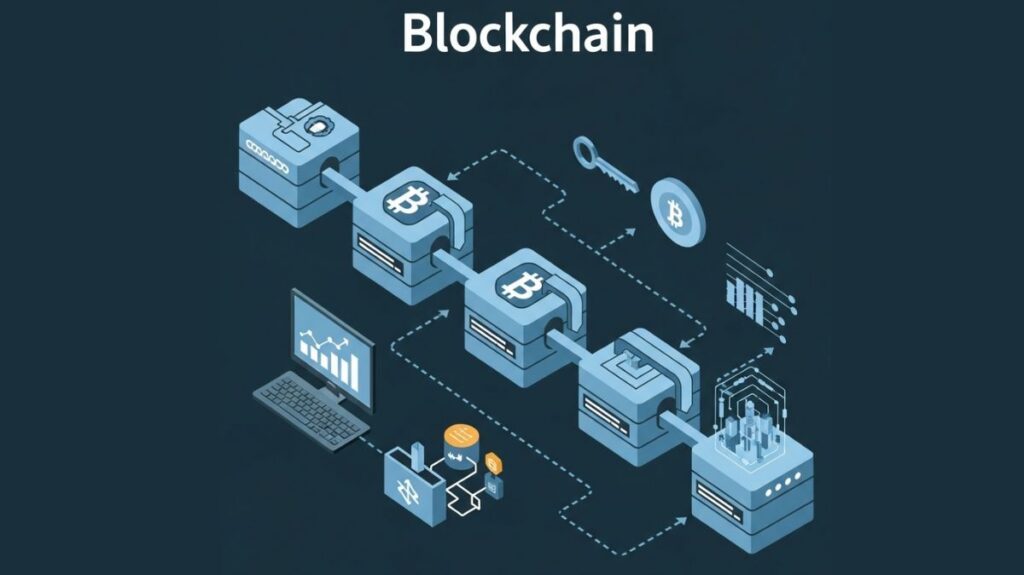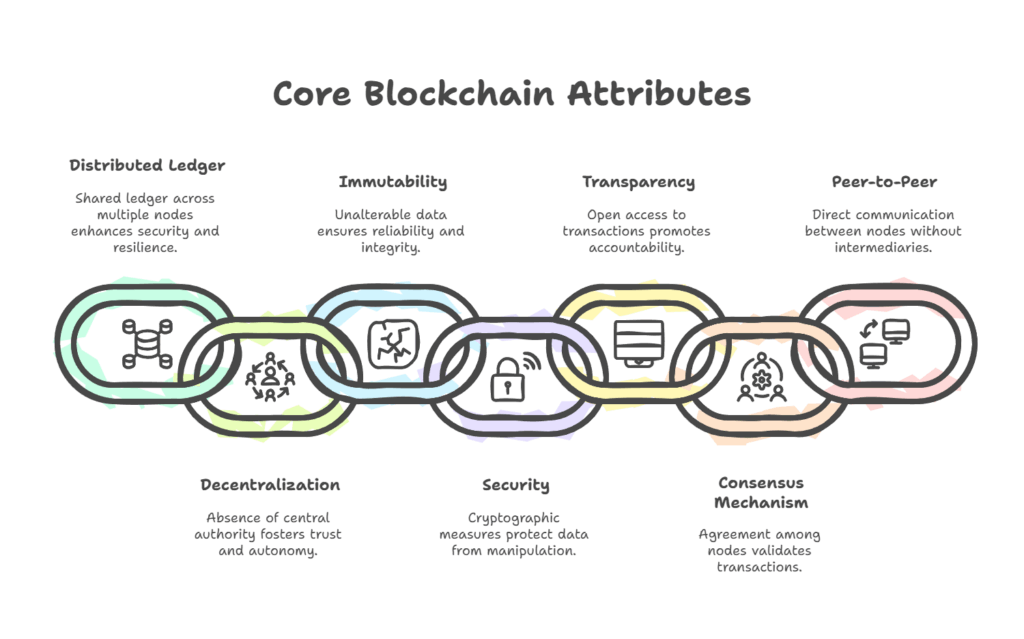What is blockchain?

The core of blockchain is distributed ledger technology. It is a transaction database. Specifically, it is a distributed digital ledger. A ledger is a chronological record of transactions. Blockchain is often called a platform or architecture. It combines established, tested ideas from cryptography and computer science into a single solution.
Origin and Connection to Bitcoin
Bitcoin is built on blockchain technology. It became a viable tech option in 2016–2017. Bitcoin was the first blockchain-based cryptocurrency, created in 2008 using many technologies. Satoshi Nakamoto’s 2008 Bitcoin: A Peer-to-Peer Electronic Cash System block chain. It may exist without cryptocurrency.
You Can Also Read About The History And Evolution Of Blockchain Technology
Structure and How it Works
Because it is a chain of blocks, the term “blockchain” refers to its technical structure.
Blocks
In a blockchain, information is kept in permanent structures known as blocks. A list or collection of transactions is contained in a block. Additionally, it contains a header with metadata like as a timestamp, a unique reference number, and most importantly for the chain a link to the block before it.
Chaining
Because each block includes the hash digest of the header of the previous block, blocks are chained together. The chain is created by this cryptographic link. The Genesis block is the first block.
Transactions
A transaction is an occurrence in which assets or resources are transferred. These are securely digitally signed in a blockchain utilising public-private key cryptography. The network broadcasts transactions, gathers them into blocks, and then verifies them. They are incorporated into the permanent record after being validated and added to a block.
Hash functions
Hash functions are essential to cryptography. A unique string created from data is called a hash. A substantial difference in hash is produced by even minor modifications to the input data. Changes can be identified with the aid of hashes. To effectively validate transactions within a block, the Merkle tree (also known as the Merkle root) structure is frequently employed. Changes are simple to identify and reject because when data in a block is altered, its hash is also altered, invalidating the connection to the subsequent block in the chain.
You Can Also Read Data Science Tutorial
Features

The following essential features of the technology allow for its special capabilities:
Distributed
Several participants (nodes) share the ledger. There is no central repository because it is implemented in a distributed manner. Each link in the chain has access to and an identical copy. By producing numerous backup copies, this distribution increases resistance to attacks and makes loss or destruction harder.
Decentralized
A central authority is usually absent from it operations. It is intended to do away with the necessity of transaction gating by a single company. Authority and control are shared. As a result, algorithms gain confidence instead of institutions.
Immutable
Information cannot be removed once it has been inputted and added to the blockchain. It is an append-many, write-once technology. Blocks cannot be changed after they are introduced. As new blocks are added, it gets harder to change older blocks. Its reliability is greatly enhanced by its immutability.
Safe
These are protected by cryptography. To guarantee data integrity and guard against manipulation, they employ cryptographic techniques like hashing and digital signatures.
Transparent
Because the ledger is shared, it is frequently accessible to all participants or freely shared among many users. This makes the transactions visible to everyone on the network. Public chains, on the other hand, are usually pseudonymous, which means that while transactions are visible, account identities may be anonymous.
Consensus Driven
Only by reaching an agreement amongst system users can the blockchain be updated. The method by which all nodes concur on which transactions are legitimate and should be appended to the blockchain is known as consensus. A central authority is no longer necessary thanks to this arrangement. There are many consensus methods, including PoS and PoW.
Peer-to-Peer (P2P)
It uses P2P technology. Without a central controller, all participants (nodes) can communicate directly with one another.
Value Proposition and Purpose
The potential of blockchain technology to foster trust between individuals or parties who would not otherwise have any motive to do so is its primary selling point. It enables entities that are distrustful of one another to communicate and exchange money without depending on a reliable third party. It has the potential to upend numerous significant sectors by eliminating middlemen or trust brokers. In order to facilitate autonomous applications, it offers a layer of trust.
Record-keeping could be revolutionized, massive quantities of record-keeping could be eliminated, supply chains could be streamlined, money could be saved, provenance could be managed and verified, and process transparency could be provided. It makes it possible to transition from a centralized digital economy to one that is democratic, open, and scalable.
You Can Also Read Machine Learning Tutorial
Blockchain Types
There are primarily two types of blockchains:
- As long as they participate in the consensus process, anyone can view or submit transactions on public blockchains, which are open source and permission-less. One example is Bitcoin.
- Private Blockchains: Also referred to as permissioned blockchains, these are controlled or maintained centrally by a single entity and limit ledger entries to entities that have been pre-screened. Authorization is necessary for access.
- Consortium blockchains are a kind of permissioned blockchain that is managed by several different organizations.
Development Beyond Bitcoin
Although the first use of the technology was Bitcoin (also known as Blockchain 1.0), it has since advanced. The creation of smart contracts executable code stored on the blockchain is a component of blockchain 2.0. More industry applications, improved scalability, interoperability, and efficiency are the goals of subsequent generations (3.0, 4.0, and 5.0). It based applications are known as decentralized applications, or DApps.
In conclusion, it is a cutting-edge, distributed, decentralized, and cryptographically secure digital ledger technology that, by means of a consensus process among participating nodes, preserves an unchangeable, transparent, and verifiable record of transactions, facilitating disintermediation and trust across a range of applications and sectors.
